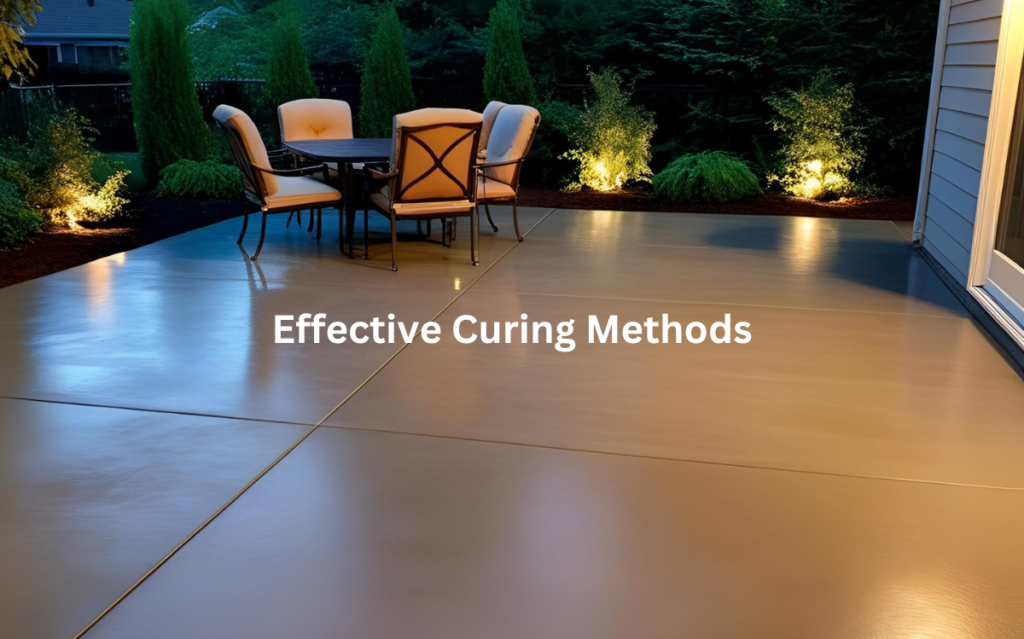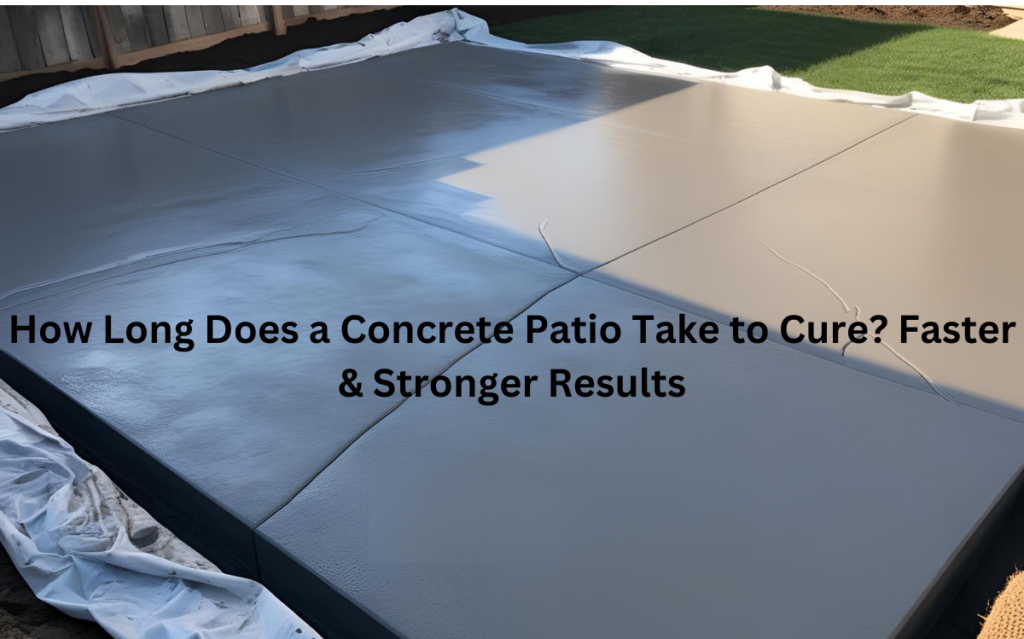Learn how long a concrete patio takes to cure, what affects curing time, and the best techniques for stronger, crack-free concrete.
A concrete patio takes about 28 days to fully cure, but light foot traffic is safe within 24-48 hours. (1) Temperature, humidity, and curing methods affect the timeline. Hot weather speeds curing but increases cracking risk, while cold weather slows hydration.
Proper techniques like water curing, plastic sheeting, or curing compounds help retain moisture and prevent surface defects.
Rushing the process weakens the concrete, leading to cracks and durability issues. For a long-lasting concrete patio, patience and the right curing methods are key.
Key Takeaway
- Full Strength Takes 28 Days – Foot traffic is okay in 24-48 hours, but heavy loads need full curing.
- Weather & Moisture Control Matter – Heat speeds curing but risks cracks; cold slows it down.
- Proper Curing Methods Prevent Issues – Water curing, plastic sheeting, and curing compounds help retain strength.
Concrete Curing Stages
Concrete curing isn’t just about drying—it’s a chemical process called hydration, where cement reacts with water to form a solid, durable structure. This process happens in stages:
- Initial Set (1-2 hours) – Concrete starts to stiffen, but it’s still workable. This is when finishing touches, like smoothing or stamping, happen.
- Final Set (4-6 hours) – The surface hardens and can’t be reshaped. However, it’s still weak and needs moisture for curing.
- Strength Development:
- 24 hours – Gains 20-30% of its final strength. It looks solid but is fragile.
- 7 days – Reaches 60-70% strength. Light loads are okay, but heavy weight may cause damage.
- 28 days – Fully cured, with nearly 100% strength. At this stage, it’s safe for cars, furniture, or construction.
Skipping proper curing during these stages can lead to weak, brittle concrete that cracks easily. (2)
Curing Duration & Load-Bearing Timeline
Just because concrete looks hard doesn’t mean it’s ready for use. Strength builds gradually, and rushing can lead to long-term damage.
- 24-48 hours – Safe for light foot traffic. Walking won’t cause damage, but avoid dragging furniture or heavy objects.
- 3-7 days – Supports lightweight items like small flower pots. Heavy furniture or grills can leave marks or cracks.
- 7-14 days – Can handle patio furniture, but avoid placing anything extremely heavy in one spot.
- 28 days – Fully cured and ready for heavy loads. If reinforced, it can support vehicles.
Patience is key. Letting concrete cure properly prevents cracks, improves durability, and ensures a long-lasting surface.
Factors Affecting Curing Time
Concrete doesn’t cure at the same rate in all conditions. Several factors—mainly temperature, humidity, and mix design—affect how long it takes to reach full strength.
- Temperature
- The ideal range is 50°F-75°F. Within this range, hydration happens at a steady rate.
- Hot weather (above 75°F) speeds up curing, but if it happens too fast, cracks form. Rapid evaporation weakens the slab.
- Cold weather (below 50°F) slows hydration. If temperatures drop below 40°F, curing can take more than 45 days. In extreme cold, concrete might never reach full strength.
- Humidity
- Low humidity makes moisture evaporate too fast, leading to shrinkage cracks.
- High humidity slows drying, which helps concrete develop strength properly.
- Concrete Mix & Additives
- Fast-setting mixes reduce curing time but may sacrifice durability.
- Retarders slow down hydration, useful in hot climates to prevent rapid drying.
Not accounting for these factors could mean weak, brittle concrete that deteriorates quickly.
Effective Curing Methods

Curing isn’t just about waiting—it’s an active process that controls moisture to ensure concrete reaches full strength. Here are the best methods:
- Water Curing
- The most effective method for strength development.
- Includes spraying water regularly, using soaker hoses, or ponding (covering the surface with standing water).
- Works best in warm, humid conditions.
- Plastic Sheeting & Curing Blankets
- Helps trap moisture and prevent rapid evaporation.
- Plastic sheeting is great for dry or windy conditions.
- Curing blankets retain heat and prevent freezing in cold weather.
- Curing Compounds
- These chemical coatings form a moisture barrier, sealing in water.
- Useful when water curing isn’t possible (e.g., on large slabs).
- Often used on highways and commercial projects.
- Wet Covering (Burlap, Mats, Fogging)
- Placing wet burlap or fabric mats on the surface keeps concrete hydrated.
- Fogging or misting works well in hot or dry climates.
Each method prevents shrinkage cracks and ensures concrete reaches its full strength potential. (2)
Common Curing Mistakes & Risks
Rushing or skipping steps during curing can weaken concrete. A patio that looks fine today might crack or crumble in a year if curing isn’t done right. Here are the biggest mistakes:
- Skipping Moisture Control – Concrete needs water to cure properly. If it dries too fast, it won’t reach full strength, making it weak and brittle.
- Letting It Cure Too Fast – Rapid drying leads to shrinkage cracks. These small cracks might not seem like a big deal at first, but over time, they can grow and weaken the entire slab.
- Not Using Protective Coverings – Wind and sun pull moisture from the surface unevenly, leading to weak spots. Covering the concrete helps prevent this.
People often assume concrete hardens by drying, but that’s only part of the process. It needs moisture, time, and the right conditions to reach full strength. Skipping these steps in installation means the patio won’t last as long as it should.
Curing in Different Weather Conditions
Weather plays a huge role in how well concrete cures. Too much heat, cold, or wind can ruin the process. Here’s how to adjust for different conditions:
- Hot Weather (Above 75°F)
- Direct sun and high temps speed up curing too much, leading to cracks.
- Keep the area shaded or use curing blankets to keep moisture in.
- Mist or fog the concrete to maintain proper hydration.
- Apply curing compounds to seal in moisture.
- Cold Weather (Below 50°F)
- Concrete cures much slower in cold temps and could take over a month if it’s below 40°F.
- Use insulated blankets to keep the slab warm and prevent freezing.
- Avoid water curing in freezing temps—it can cause ice to form, damaging the concrete.
- Windy/Dry Conditions
- Wind evaporates moisture too quickly, leading to weak, brittle concrete.
- Cover the slab with plastic sheeting or wet burlap to hold in moisture.
- Increase water curing frequency to keep hydration levels steady.
Ignoring the weather during curing can lead to long-term damage. Adjusting your approach based on conditions ensures the concrete reaches full strength and lasts for decades.
Curing vs. Drying: Key Differences
Curing and drying sound similar, but they mean different things. Curing is what makes concrete strong. It happens when water reacts with cement, a process called hydration. This takes about 28 days and requires moisture. Without enough water, concrete won’t reach its full strength.
Drying, on the other hand, is about getting rid of extra water. When concrete is poured, it has more water than it needs for curing. This excess water slowly evaporates over several months. Even when concrete feels dry on the surface, deep inside, it still contains moisture.
A common myth is that concrete “fully dries” in 24 hours. In reality, after a day, it has only 20-30% of its final strength. Rushing drying can cause cracks, surface shrinkage, and weak spots. That’s why curing should always come first. Drying can wait—strength and durability can’t.
Best Practices for Stronger & Faster Curing
For the best results, curing needs moisture, time, and protection. Here’s how to do it right:
- Control Temperature & Humidity – If it’s too hot, concrete dries too fast, leading to cracks. If it’s too cold, curing slows down. Ideal curing temperatures are 50°F-75°F.
- Use Chemical Curing Agents – These seal moisture inside the concrete, preventing rapid evaporation. They’re especially helpful in hot, dry conditions.
- Keep Concrete Hydrated – Cover the surface with plastic sheeting, burlap, or wet mats. This traps moisture and helps curing. Spraying water regularly also works.
- Protect Against Wind & Sun – Direct sunlight and wind speed up evaporation, making curing uneven. Use shade, misting, or covers to prevent moisture loss.
Skipping these steps could lead to brittle, cracked concrete that won’t last. Taking the time to cure properly means a stronger, more durable patio that will hold up for years.
Conclusion
A concrete patio isn’t just about pouring and waiting—it’s about controlling hydration, managing moisture, and avoiding mistakes that lead to weak spots.
Whether it’s hot, cold, dry, or humid, adjusting curing methods ensures stronger, crack-free results. Don’t rush it. The difference between a 10-year patio and a 50-year one? Proper curing.
Need expert help with your concrete patio? Lapis Patios delivers high-quality outdoor spaces with craftsmanship you can trust.
FAQ
Can I speed up concrete curing without affecting strength?
Speeding up curing is tricky. Concrete needs time to gain strength, and rushing the process can lead to cracks or weak spots. However, in some cases, calcium chloride or other accelerators can be added to the mix to help concrete set faster, especially in cold weather.
Using curing blankets in winter or curing compounds in dry conditions can also help maintain moisture while slightly reducing overall curing time. The key is moisture retention—if the concrete loses water too quickly, it won’t reach full strength, even if it appears dry on the surface.
What happens if I place furniture on a patio before it’s fully cured?
Placing heavy furniture too soon can create permanent dents or cracks in the concrete. Even if the surface seems hard, the inside is still gaining strength. Furniture legs can press into the soft concrete, leaving marks that won’t go away.
Worse, concentrated weight—like a grill or fire pit—can lead to uneven curing, weakening the slab. To avoid this, wait at least 7 days before adding light furniture and a full 28 days for heavier pieces. Rushing this step could mean costly repairs later.
Does the thickness of the patio affect curing time?
Yes! Thicker slabs take longer to cure because more concrete means more moisture to retain. A standard 4-inch patio may cure within 28 days, but a 6-inch slab can take longer, especially in cold weather. The deeper the concrete, the more time it needs for even hydration.
If the slab is extra thick—like 8 inches or more—it might need special curing techniques, like extended water curing or slow-drying methods. Ignoring thickness differences could lead to a strong surface but a weak core, which may cause internal cracking over time.
Does curing time change if my patio has a decorative finish?
Absolutely! Stamped, stained, or sealed concrete needs extra curing attention. Stamped concrete requires moist curing for the first few days to prevent surface cracking. If using stain, applying it too early can trap excess moisture, leading to discoloration or peeling.
Sealers should only be applied after the patio is fully cured—usually after 28 days—to avoid trapping water inside. If you rush the process, decorative finishes may not bond properly, resulting in a patio that looks good at first but deteriorates over time.
How does weather affect concrete curing time?
Weather is one of the biggest factors in curing. Hot weather makes concrete dry too fast, leading to shrinkage cracks.
In extreme heat, keeping the surface damp with fogging or wet burlap helps slow evaporation. Cold weather slows curing significantly—below 40°F, concrete may take over 45 days to fully cure. If temps drop below freezing too soon, the moisture inside can freeze, causing cracks.
Windy or dry climates also require extra care, as rapid evaporation weakens the top layer. Monitoring temperature, humidity, and wind ensures a patio that cures evenly and lasts longer.
References
- https://www.concretenetwork.com/curing-concrete/
- https://www.researchgate.net/publication/383926013_A_Review_on_the_Curing_of_Concrete_using_Different_Methods

